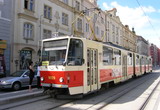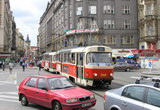Prague
Go to English main page
| A brief history | Trams as the base | No for changing | Standard frequency | Top usage of public transport | Where to go on |
By Antero Alku, M.Sc. eng.
A brief history
The time of public transport dates back to year 1875 when horse driven tramways started to operate in

Map of the planned underground tramway lines in the city sentre of Prague. The work started in 1966 but was soon cancelled. A Soviet style metro started to operate in 1974.
Top of the page.
Trams as the base
In many cities the building of the metro has meant the removal of the trams at least in the city centre. In
The 141 kilometres tram network is the base of the public transport of today's
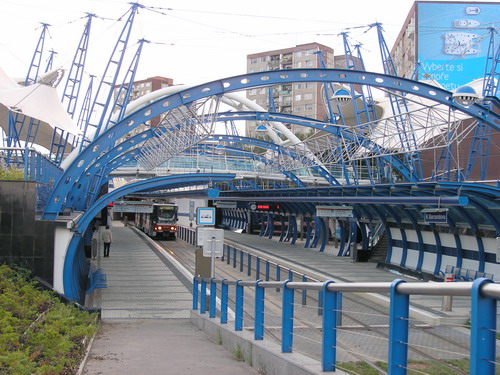
The new suburb tramway line to Sidliste Barrondov to south is built with fine architecture. Each stop has it's own color. Here K Barandovu with it's blue atmosphere. Stops are located immediately beside the housing. Foto 25.7.2005 by A Alku.
Buses serve the sites where rail transport is not available. Many metro stations has connecting bus line terminals. Tram lines have several common stops with buses so any terminals are not required to change between trams and buses. Some stops are made to serve as organized interchange stops where several tram and bus lines and possibly a metro line too stop the same time. The stop last so long that there is time to change from each coach to another.
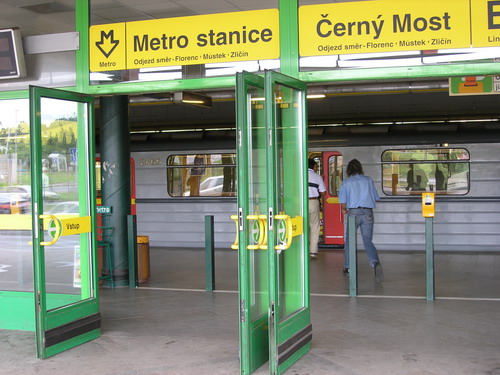
To change between a bus and the metro can be made easy and it is made easy in Prague. This picture is taken from the bus stop, from where is a straight and short walk to a metro platform and to the train. Foto 31.7.2005 by A Alku.
Top of the page.
No for changing
The clever in the public transport network in
The tram track network is not only a star having 12 fingers. There are also tracks between the fingers forming orbital connections.
The tram line network is well suited to the track network. No tram line has end stop in the city centre, so all the lines work as a pendulum. Each ”finger” has two to four lines, which all lead to different fingers on the opposite side of the city centre. So theoretically there are two to four destination directions from each part of the city to travel without a need to chance.
Each finger also offers a line, which crosses all the other lines. So each stop on the network can be reached with no more than one change from any other stop on the network. And what is important, to change does not require long distance to walk and use stairs. Most often the passenger only needs to exit the tram to the stop platform and wait there for the suitable tram to come. So when ever it is necessary to change, it is the easiest way to do it.

Colour coded line map gives a good idea of the organisation of the tram lines in Prague. All the lines in one ”finger” ends to different figers on the other side of the city. The map is linked from the site of Prague public transport authority.
Top of the page.
Standard frequency
The service level of the
The standard frequency is 10 minutes. As most part of the track network has more than one line, the service frequency at the stops is 2,5 to 5 minutes. This also means that there is no need to fit the change times, as the average waiting time is very short any way. The changing is synchronized with the timetables only in evening when the frequencies are longer.
Trams follow the timetables precisely. The traffic is followed by a central computer. On the track network there are several check points where the tram communicates with the system and adjusts the location and time information in the trams computer. The driver has a display that shows the difference from the timetable. So it is easy for the driver to either slow down or hurry to be precisely in time.
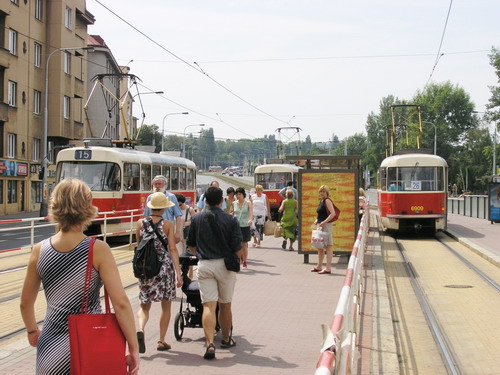
Interchange stop Hradcanska. In the evenings timetables are synchronized and trams, buses and metro trains stay here same time so that there is possible to change between all the lines. Foto 27.7.2005 by A Alku.
Top of the page.
Top usage of public transport
The public transport system in
The value of this result increases with the number of cars in
Another side of the coin is the subsidy. The income of the Public transport authority per trip is 0,083 euros when all the expenses are 0,35 euros per trip. But it may well be so, that to pay for all the expenses required for increasing car usage is far more than the near 300 million euros for public transport (in year 2003). There are also remarkable investments going on, and the details of the economy and cost of traffic expenses only are not known by the writer.
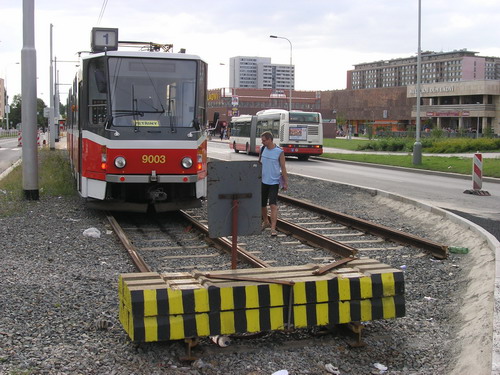
A metro never replaces on ground public transport, trams and buses. In Prague parallel tram lines still remain after building of a metro line. In Ládvi there is a metro extension work going on what for the tram line is temporally cut. Foto 26.7.2005 by A Alku.
Top of the page.
Where to go on
It is seen in the public transport in
For handicapped passengers there are today special buses and bus lines. Low floor buses are delivered during the last years. With the trams the renewal of the fleet takes more time. The purchase of low floor trams is going on after a test set of 4 trams in 1996. The 8-axle articulated KT8D-units could be converted to partially low floor. A prototype of this already exists. See the picture at an enthusiast internet site. The latest metro extensions have lifts and some also short connections on the same platform with buses and trains.
Most of the Tatra trams are 4 axle and look old. They are used as trains of two cars to increase the passenger capacity. But all the old round shaped T3 trams has electronic chopper based speed control and many of these brake power back to the catenary. Some have also new interior that looks like the most modern trams. The lack of low floor and better accessibility is their only problem.
The easiest potential to increase the efficiency of the public transport is to clearly close for the cars those streets or lanes trams use in the city centre. There are already pedestrian areas in the centre, so those must only be extended to all tram tracks.

The problem of the public transport is private car, not vice versa. In Prague the private car is a sign of freedom and standard of lifving as in many former socialistic countries. That is a reason why it is difficult to limit car usage, even there are real pedestrian areas in the city. Foto 26.7.2005 by A Alku.
I would not recommend to extend the metro. Instead money should be put to build lifts and roller stairs. As the renewal of the last Soviet rolling stock is ahead, I would seriously think of converting the green line to a Stadtbahn type tram line.
The integration with the trains should also be discussed, as the potential of the existing railway tracks is practically unused. The metro green line, railway lines and suitable part of the tram network could be operated with a Karlsruhe-like tram trains. They have the same capacity as the recent metro trains with same width, but they can operate also on streets and existing tram tracks. They can be a key to extend the rail transport to airport too.
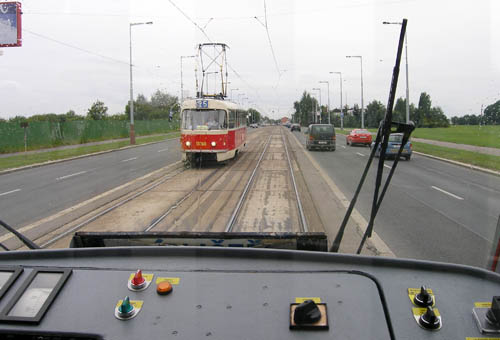
The tram lines continues up to the borders of the city. The integration of tram, metro and railway lines using dual voltage Tram Train rolling stock as in Karlsruhe Germany is worth for a serious discussion. Foto 25.7.2005 by A Alku.
Top of the page.
Page is created at 24.7.2006 / AA
